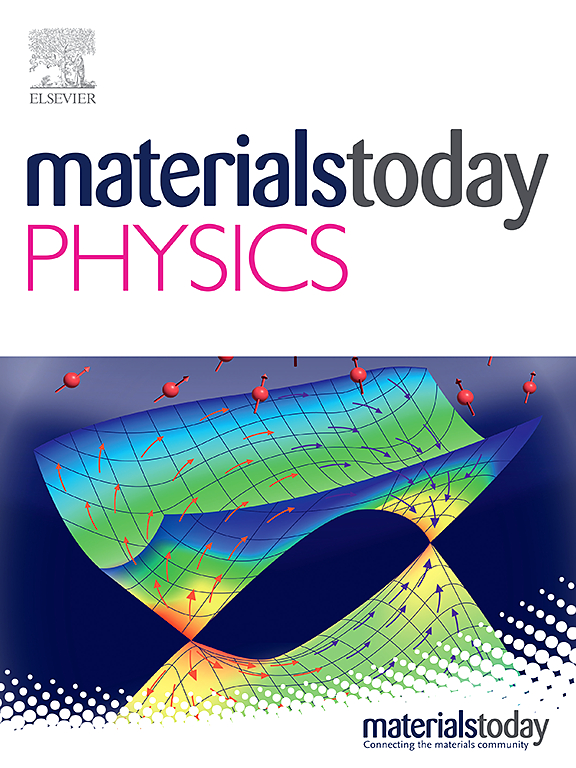溶剂工程镍基电催化剂的同时析氢和PET塑料废物升级回收
IF 9.7
2区 材料科学
Q1 MATERIALS SCIENCE, MULTIDISCIPLINARY
引用次数: 0
摘要
聚对苯二甲酸乙二醇酯(PET)塑料垃圾的大量积累迫切需要可持续的资源回收策略。传统的PET回收与有效增值乙二醇(EG)的斗争,一个主要的解聚副产物,限制了经济可行性和材料循环。本研究通过溶剂调节策略设计了NiMo双功能电催化剂,以协同驱动析氢(HER)和EG氧化(EGOR),实现塑料升级回收和绿色H2生产的一体化。通过调整水/EG的比例,可以精确控制相组成和纳米结构的演变,这是由溶剂极性相关的动态重建控制的。富水合成的NiMo-W30纳米棒具有优化的氢吸附动力学,具有优异的HER活性(η10 = 8.21 mV, Tafel斜率= 36.5 mV dec1)。相反,以EGOR为主的合成产生超薄的NiMo-W0.5EG29.5纳米片,其中原位Mo浸出产生富含Ni3+的活性位点,通过选择性EGOR对甲酸的选择性达到93%。集成这些催化剂的膜电解槽同时将10 g PET升级为8.43 g对苯二甲酸和7.76 g二甲酸钾,同时在1.58 V下产生94.86 mmol H2,比传统的水分解高出208 mV。技术经济分析证实,处理每吨PET的净利润为244美元,与传统电解水的261美元损失形成鲜明对比。这项工作为塑料增值和可持续催化剂设计建立了一个闭环范例。本文章由计算机程序翻译,如有差异,请以英文原文为准。


Solvent-engineered NiMo-based electrocatalysts for simultaneous hydrogen evolution and PET plastic waste upcycling
The massive accumulation of polyethylene terephthalate (PET) plastic waste urgently requires sustainable resource recovery strategies. Conventional PET recycling struggles with efficiently valorizing ethylene glycol (EG), a major depolymerization byproduct, limiting economic viability and material circularity. This study designs NiMo bifunctional electrocatalysts via a solvent-modulated strategy to synergistically drive hydrogen evolution (HER) and EG oxidation (EGOR) for integrated plastic upcycling and green H2 production. By adjusting water/EG ratios, precise control over phase composition and nanostructure evolution is achieved, governed by solvent-polarity-dependent dynamic reconstruction. Water-rich synthesis yields NiMo-W30 nanorods with optimized hydrogen adsorption kinetics, delivering exceptional HER activity (η10 = 8.21 mV, Tafel slope = 36.5 mV dec−1). Conversely, EG-dominated synthesis produces ultrathin NiMo-W0.5EG29.5 nanosheets, where in situ Mo leaching generates Ni3+-rich active sites, achieving 93 % selectivity for formic acid via selective EGOR. A membrane electrolyzer integrating these catalysts concurrently upgrades 10 g PET into 8.43 g terephthalic acid and 7.76 g potassium diformate while generating 94.86 mmol H2 at 1.58 V, surpassing conventional water splitting by 208 mV. Techno-economic analysis confirms a net profit of $244 per ton of PET treated, contrasting sharply with the $261 loss of traditional water electrolysis. This work establishes a closed-loop paradigm for plastic valorization and sustainable catalyst design.
求助全文
通过发布文献求助,成功后即可免费获取论文全文。
去求助
来源期刊

Materials Today Physics
Materials Science-General Materials Science
CiteScore
14.00
自引率
7.80%
发文量
284
审稿时长
15 days
期刊介绍:
Materials Today Physics is a multi-disciplinary journal focused on the physics of materials, encompassing both the physical properties and materials synthesis. Operating at the interface of physics and materials science, this journal covers one of the largest and most dynamic fields within physical science. The forefront research in materials physics is driving advancements in new materials, uncovering new physics, and fostering novel applications at an unprecedented pace.
 求助内容:
求助内容: 应助结果提醒方式:
应助结果提醒方式:


